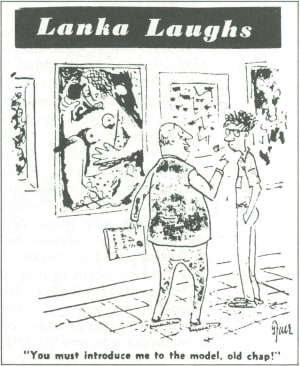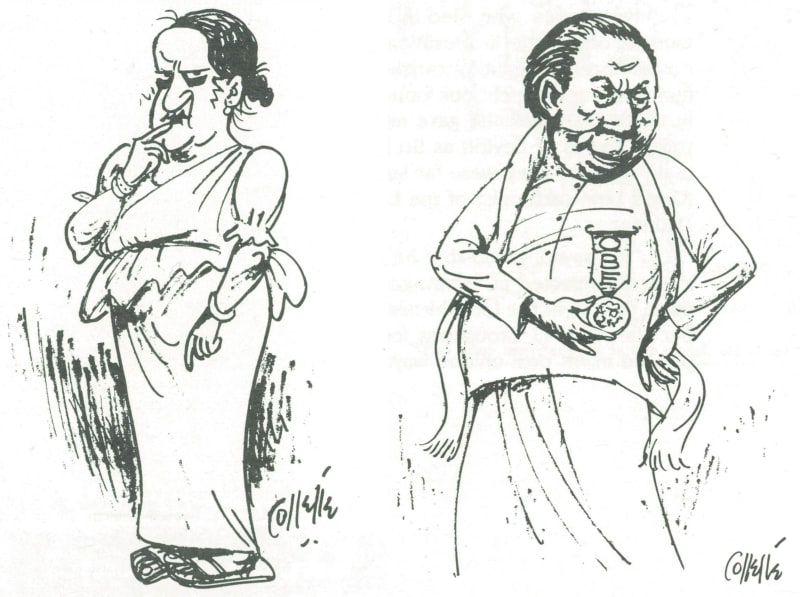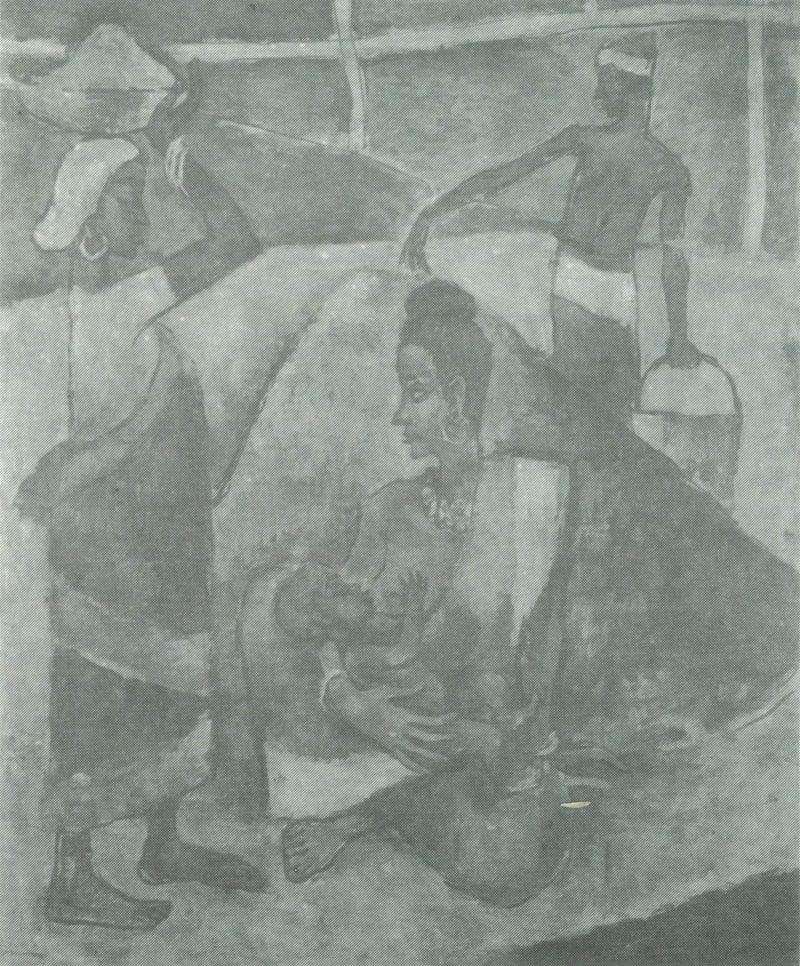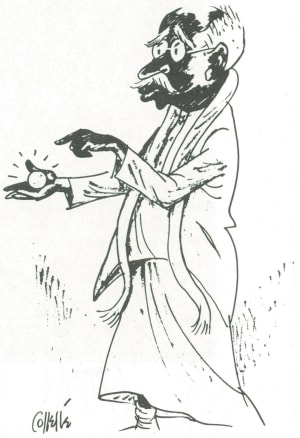Aubrey Collette (5 September 1920 - 8 January 1992)
Chapter IX
Collette's Cullings
The satirist’s fine line
Everybody enjoyed Aubrey Collette’s work though he would not have satisfied every political aspiration. You turned to him for your reading of the day, originally in the Times of Ceylon, later in the Observer, and then as ‘Spur’ in a series he did for the Daily News as well. He gave a sharp edge to his drawing which, indeed, was capable of cutting deeply but never maliciously. Collette had the rare and splendid gift of observation: to remember a foible, to swiftly size up a characteristic, and enjoy having summed up the hapless one who had fortuitously wandered into his sights. To have been noticed by Collette was itself honour enough, and those who had been so distinguished by a portrait, as in Collette’s 1954 FACES – a collection of seventy-three pastel studies – soon bought them up, more for the immortality it conferred on them than for the fear of what their enemies might make of the caricatures. Collette very simply had the gift of showing some how others saw them, bestowing upon them the poet’s wish. You might have rejected these insights as subjective had you not yourself been drawn inevitably into the process of assessing the subject.

COLLETTE: Cartoon comment in the Observer following a ‘43 Group exhibition.
His subjects were mainly politicians and people in public places whose frequent if not daily appearance in the newspapers made them household faces. Collette’s remarkable talent was to summarise them, not just for their appearance but for what they truly were. Dr G. P. Malalasekera wore his OBE perpetually pinned on to his white shirt; C. W. W. Kannangara held aloft the pearl of great price of free education – small symbols to mark their special vanities. Of course he was blessed in a very special way when he was chosen to be born into the Sri Lanka of that exquisite time between the dying days of colonialism and the promises of an era of Independence. ‘The Soulbury Constitution provided me with the material:’ he said. He told S. P. Amarasingham that while still a teacher “the Times of Ceylon saw fit to publish my cartoons, but this soon brought me into conflict with the then Minister of Education and the Public Service Regulations, and I was compelled to leave Royal and join the staff of the Times as a full-time cartoonist.” Now he had them on a platter, a gathering of very remarkable people, each a living caricature of himself, unwittingly offering themselves for treatment despite their own best efforts to avoid Collette’s satirical brush. Some of his views may have seemed cruel at the time for all the self-importance and arrogance of politician and bureaucrat, but in the end he saw them for what they were – thoroughly vulnerable in their humanity and not a little pathetic. I prefer such a charitable view. It would not have been in character for Collette to pronounce harsh judgements on people or for himself to strike a high moral note over them, though that was indeed his role as a critic of the political and social milieu of the day.
To achieve this Collette had formidable equipment. His draughtmanship was impeccable and that gave him the ability to distort without losing the essential features of his subject. He could exaggerate, cut up, dissect and even put a person together back to front while retaining the undeniable likeness of his victim. This was an uncanny gift but, as I say, something that grew and was nurtured in his unique cast of performers. Jayanta Padmanabha was overawed by Collette’s skill. He said after a visit to Collette’s 1954 exhibition of caricature portraits, that he wished he “could use words as effectively as Collette can use line and colour” so as to do justice “to the superlative exhibition of this notable artist’s work …” Turzie Vitachchi it was. I think, who said in a note which appeared in the catalogue that there was “almost a miraculous tendency for Collette’s subjects to look more and more like his caricatures of them.” Padmanabha’s summary was of the essence. After two visits to this exhibition he wrote in the Sunday Observer of 31 October 1954 that he had asked himself what qualities were required for a great caricaturist. He decided: “Excellent draughtsmanship is perhaps the first requisite; exceptional gifts as a portraitist pure and simple; penetrating insight superlative powers of observation and a well-trained visual memory; a rare combination of detachment from the subject with a lively interest in his or her foibles and eccentricities as a human being; good humour tempered with a keen sense of the ridiculous; a streak of malice restrained by humanity and good taste.” All of these requirements were fulfilled to an extraordinary degree in Aubrey Collette.

COLLETTE: Daily News cartoon
His involvement with the ‘43 Group goes back to its inception, when in the company of Ivan Peries, they had taken part in “the gathering of the fold.” Collette and Ivan Peries had met as mentioned elsewhere in this account at David Paynter’s art class in Boyd Place. Colombo – Paynter having just returned from England after very successful studies at the Royal Academy schools. Paynter’s “only other pupil was a certain Ivan Peries,” recalled Collette in a Melbourne radio broadcast in 1990. He went on to say: “David Paynter deserted us in a matter of months, but Ivan and I became firm friends. We were both studying for post-matric exams and found little time for painting, but it became clear that Art was going to make more and more demands on our lives. At that time the position of Art Master at Royal College became vacant and unbeknown to each other, we both applied. I got the job and saved Ivan from a fate worse than death.”
Geoff Beling saw Collette’s work at Royal College as being among the brighter expressions of the new method in art education. He organised exhibitions of the work of his pupils, sharing one of these shows with the pupils of Richard Gabriel at St Joseph’s. Among his pupils were at least three who were to develop into important artists in their own right: Ranjit Fernando who conducted the affairs of the Group in Europe in the nineteen fifties; Gamini Warnasuriya, now an architect in Perth, Western Australia; and Tissa Ranasinghe, the sculptor, now living in England.

COLLETTE: Seated Woman. Oil on board (45.5cm x 61cm) Pauline Collette Collection, Melbourne. Photography by Amahl Weereratne
Ivan Peries, who died in London in 1988, published a memoir of Collette in a catalogue in 1984. He said: “He used to do some really beautiful caricatures on bits of paper. So I got a hundred page sketchbook bound in canvas and I gave it to him. In about two weeks he gave me the sketchbook filled with all the public figures of Ceylon as Sri Lanka was then known. They were really superb. They were far superior to the cartoons of Low. (David Low, cartoonist of the London Times); much more like Daumier.
“I always insisted that he was a very fine painter which he modestly rejected as extravagant. He was influenced in those days, that is, in the late thirties, by the Americans of that period, but after the ‘43 Group was founded his style changed and he painted in his own unique way. His work had the luminosity of Justin Daraniyagala. His Boy with Flute is in oyster, shell pink and browns and I think with its paint quality it stands out as one of the best pictures painted by a member of the ‘43 Group.”

COLLETTE: Mrs Sirima Bandaranaike (left), and Dr G. P. Malalasekera. Brendon & Yasmin Gooneratne Collection. Sydney
On another occasion Ivan Peries described Collette’s oils as painted with “immense verve. His metalic colours, harsh and uncompromising lines are to some extent modified by luminous colour and quite delicate yet robust handling. The social comment is always there and gives greater value to the work of art without in any way detracting from the formal qualities on which the permanence of any work must depend:’
In a tribute paid to him at his death George Claessen, a colleague in the ‘43 Group now living in London, wrote: ‘Aubrey Collette possessed a serious mind, kindly, without pretence of any kind and devoid of envy. In the fulfilment of his work as a cartoonist, a direction in which he was especially gifted, he was never vitriolic in a destructive way: rather. I would say, with an inward smile at the antics and capers in the human comedy … He was a perspicacious judge of art in all its manifestations …” In an obituary tribute published in the Sri Lankan, a now-defunct Melbourne-based periodical, Vernon Abeysekera recalled how Collette had admitted that he had never been happier than when he worked in Sri Lanka. He said: “Cartooning there had been an inspiration. In other places (Sydney, Melbourne and Singapore) it was little more than employment. His characters there (in Sri Lanka) were people he knew first-hand. They sprang out of a culture in which he had himself been nurtured and the problems they reflected where close to his heart.”
The artists of the ‘43 Group, and the members of the Ceylon Society of Arts were easy victims of Collette’s laughter. He painted two water colour groups of these people, one called ‘43 Fresco, the other Reminiscence Fresco showing among other noteworthy persons, the amateur magician Mudaliyar A. C. G. S. Amarasekera pull a rabbit out of a hat, the doyen of artists pulling off another trick.

COLLETTE: Tamil Labourers. Oil on canvas (94cm x 112cm) Anton Wickremasinghe Collection
Collette used to say that his first interest was drawing but that it was Ivan Peries who drew him into painting. Painting may not have been his avocation, but when he did paint he certainly evoked expressions of deep interest. For instance, a critic writing on the fourth exhibition of the Group found a picture of Collette’s called African Soldier to be “a vigorous painting from which the hallmark of the cartoonist is fortunately missing.” Maurice Collis writing in London’s Art News on the first exhibition of the Group in London in November 1952 considered Collette’s Jamil Labourers “originally composed:’ Stephen Bone writing in the Manchester Guardian of 15 January 1954 listed among the notable items at the exhibition at the Artists International Association Gallery in Leicester Square. Collette’s “straightforward, effective oil paintings depict(ing), decoratively simplified, the activities of people in the street.” William Graham (in The Studio), Found Collette’s work “a fairly direct interpretation of life.”

COLLETTE: C. W. W. Kannangara. Brendon & Yasmin Gooneratne Collection. Sydney
In later years, freed from the responsibilities that grew from his involvement with local politics and following his retirement from the Associated Newspapers of Ceylon, Collette began to paint with greater earnestness.
Throughout all this, Collette remained always a shy and modest person never claiming any special place for himself. However, no-one can gainsay Collette’s his stature. Other cartoonists practising in Sri Lanka paid him the ultimate compliment of endeavouring to imitate his style and even of copying the detail of his caricature.